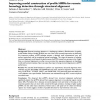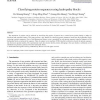179 search results - page 11 / 36 » Structure recognition on sequences with a neuro-fuzzy-system |
BMCBI
2007
13 years 8 months ago
2007
Background: Protein remote homology detection is a central problem in computational biology. Most recent methods train support vector machines to discriminate between related and ...
BMCBI
2007
13 years 8 months ago
2007
Background: Remote homology detection is a challenging problem in Bioinformatics. Arguably, profile Hidden Markov Models (pHMMs) are one of the most successful approaches in addre...
RECOMB
2001
Springer
14 years 9 months ago
2001
Springer
A method is presented that uses b-strand interactions to predict the parallel right-handed b-helix super-secondary structural motif in protein sequences. A program called BetaWrap...
PR
2006
13 years 8 months ago
2006
The annotation of proteins can be achieved by classifying the protein of interest into a certain known protein family to induce its functional and structural features. This paper ...
ACL
2009
13 years 6 months ago
2009
While Active Learning (AL) has already been shown to markedly reduce the annotation efforts for many sequence labeling tasks compared to random selection, AL remains unconcerned a...


